
Hornets are the largest of the eusocial wasps, and are similar in appearance to their close relatives yellowjackets. Some species can reach up to 5.5 cm (2.2 in) in length. They are distinguished from other vespine wasps by the relatively large top margin of the head. Worldwide, 22 species of Vespa are recognized. Most species only occur in the tropics of Asia, though the European hornet is widely distributed throughout Europe, Russia, North America, and north-eastern Asia. Wasps native to North America in the genus Dolichovespula are commonly referred to as hornets, but all of them are actually yellowjackets.
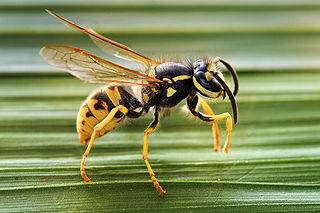
The Vespidae are a large, diverse, cosmopolitan family of wasps, including nearly all the known eusocial wasps and many solitary wasps. Each social wasp colony includes a queen and a number of female workers with varying degrees of sterility relative to the queen. In temperate social species, colonies usually last only one year, dying at the onset of winter. New queens and males (drones) are produced towards the end of the summer, and after mating, the queens hibernate over winter in cracks or other sheltered locations. The nests of most species are constructed out of mud, but polistines and vespines use plant fibers, chewed to form a sort of paper. Many species are pollen vectors contributing to the pollination of several plants, being potential or even effective pollinators, while others are notable predators of pest insect species, and a few species are invasive pests.

Vespula is a small genus of social wasps, widely distributed in the Northern Hemisphere. Along with members of their sister genus Dolichovespula, they are collectively known by the common name yellowjackets in North America. Vespula species have a shorter oculomalar space and a more pronounced tendency to nest underground than Dolichovespula.

Paper wasps are vespid wasps and typically refers to members of the vespid subfamily Polistinae, though it often colloquially includes members of the subfamilies Vespinae and Stenogastrinae, discussed elsewhere, which also make nests out of paper. Paper wasp nests are characterized by open combs with down pointing cells. Some types of paper wasps are also sometimes called umbrella wasps, due to the distinctive design of their nests.

The longhorn beetles (Cerambycidae), also known as long-horned or longicorns, are a large family of beetles, with over 35,000 species described.

The Asian giant hornet or northern giant hornet, including the color form referred to as the Japanese giant hornet, is the world's largest hornet. It is native to temperate and tropical East Asia, South Asia, Mainland Southeast Asia, and parts of the Russian Far East. It was also found in the Pacific Northwest of North America in late 2019 with a few more additional sightings in 2020, and nests found in 2021, prompting concern that it could become an invasive species. However, by the end of the season in November 2022, there were no confirmed sightings in North America at all, suggesting they may have been eradicated in that region.

The European hornet is the largest eusocial wasp native to Europe. It is also the only true hornet found in North America, having been introduced to the United States and Canada from Europe as early as 1840. Vespines, such as V. crabro, are known for making intricate paper-like nests out of surrounding plant materials and other fibers. Unlike most other vespines, reproductive suppression involves worker policing instead of queen pheromone control, as was previously thought.

The median wasp is a species of social wasp of the family Vespidae found throughout Europe and Asia. It builds aerial paper nests often in shrubs or trees, and occasionally under the eaves of buildings. It is most common to see this wasp between May and October during its 3.3 month colony cycle. Behaviours of this wasp include nest defense, curling which is believed to function in brood incubation, and gastral vibration which is involved in larval feeding. The median wasp has a halplodiploid sex determination system that results in a high level of relatedness within the colony. This species is not usually aggressive but will sting if they feel their nest is threatened. Most foraging in the nest is done by the workers once the first ones reach adulthood. These workers forage for insects, nectar, and wood for nest construction in temperatures as low as 7 °C (45 °F). The median wasp is known to be occasionally affected by the fungus Cordyceps sphecocephala and the Cricket paralysis virus.
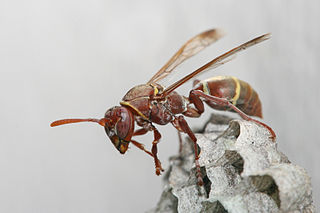
The Polistinae is a subfamily of eusocial wasps belonging to the family Vespidae. They are closely related to the wasps and true hornets of the subfamily Vespinae, containing four tribes. With about 1,100 species total, it is the second-most diverse subfamily within the Vespidae, and while most species are tropical or subtropical, they include some of the most frequently encountered large wasps in temperate regions.

Dolichovespula is a small genus of social wasps distributed widely throughout the Northern Hemisphere. The yellow and black members of the genus are known by the common name yellowjackets in North America, such as Dolichovespula norwegica, along with members of their sister genus Vespula. In a study on the nesting biology of Dolichovespula, a colony of D. maculata with 771 workers was reported as having the largest recorded population count.

Honey wasps are species in the genus Brachygastra of the family Vespidae. Brachygastra comprises 17 species of social paper wasps. The ancestral species are thought to have diverged about 32 million years ago within diverse Amazonian rainforest. Subsequent speciation within the genus is thought to have mostly occurred between 23 Ma and 10 Ma, during the time of the Andean uplift when the landscape was significantly altered due to tectonic activity. The current cladistic organisation of the genus has been heavily reliant on morphological characteristics.

Provespa is a small genus of Vespidae, made up of nocturnal wasps from Southeast Asia, sometimes referred to as "night wasps" or "night hornets", though they are not true hornets. They are the only nocturnal members of the subfamily Vespinae, and also the only vespines where new colonies are formed by swarming. They tend to build their nests from fibrous plant material, making them a uniform greyish brown colour which is often difficult to locate.

The Stenogastrinae are a subfamily of social wasps included in the family Vespidae. They are sometimes called hover wasps owing to the particular hovering flight of some species. Their morphology and biology present interesting peculiarities.

A wasp is any insect of the narrow-waisted suborder Apocrita of the order Hymenoptera which is neither a bee nor an ant; this excludes the broad-waisted sawflies (Symphyta), which look somewhat like wasps, but are in a separate suborder. The wasps do not constitute a clade, a complete natural group with a single ancestor, as bees and ants are deeply nested within the wasps, having evolved from wasp ancestors. Wasps that are members of the clade Aculeata can sting their prey.
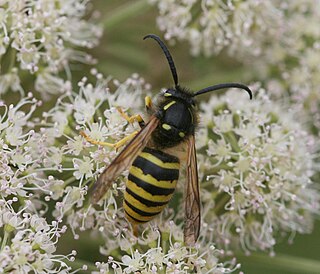
The tree wasp is a species of eusocial wasp in the family Vespidae, found in the temperate regions of Eurasia, particularly in western Europe. Despite being called the tree wasp, it builds both aerial and underground paper nests, and can be found in rural and urban habitats. D. sylvestris is a medium-sized wasp that has yellow and black stripes and a black dot in the center of its clypeus. It is most common to see this wasp between May and September during its 3.5 month colony cycle.
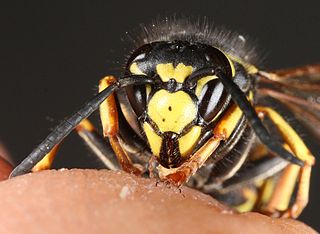
Vespula austriaca is an obligate parasitic wasp, parasitizing the nests of other species in the genus Vespula in the Old World. Its common host species include V. rufa in Europe, Japan, and East Siberia.V. austriaca wasps pollinate orchids.
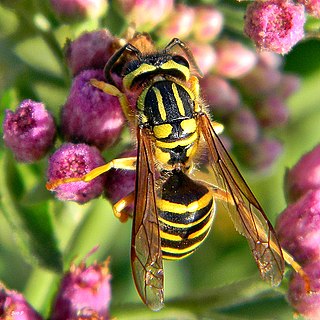
Vespula squamosa, or the southern yellowjacket, is a social wasp. This species can be identified by its distinctive black and yellow patterning and orange queen. This species is typically found in eastern North America, and its territory extends as far south as Central America. Within these territories, they create enormous, multiple-comb nests. The colonies may be either annual or perennial depending on the climate, and in many perennial nests, polygyny takes place. In addition, this species uses pheromones both as a sexual attractant and an alarm signal. This species feeds on insects and animal carcasses; it does not produce honey. V. squamosa, a social insect, has developed a parasitic relationship with the species V. vidua and V. maculifrons. Due to their painful, venomous stings, the species is considered a pest.

Dolichovespula arenaria, also known as the common aerial yellowjacket, sandhills hornet, and common yellow hornet, is a species of wasp within the genus Dolichovespula widely distributed in the North American continent.

Polistes bellicosus is a social paper wasp from the order Hymenoptera typically found within Texas, namely the Houston area. Like other paper wasps, Polistes bellicosus build nests by manipulating exposed fibers into paper to create cells. P. bellicosus often rebuild their nests at least once per colony season due to predation.
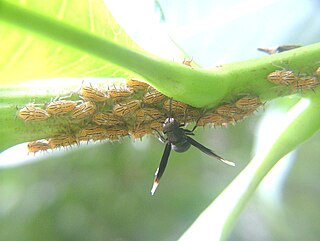
Parachartergus is a genus of epiponine social wasps belonging to the subfamily Polistinae. Species include:





















